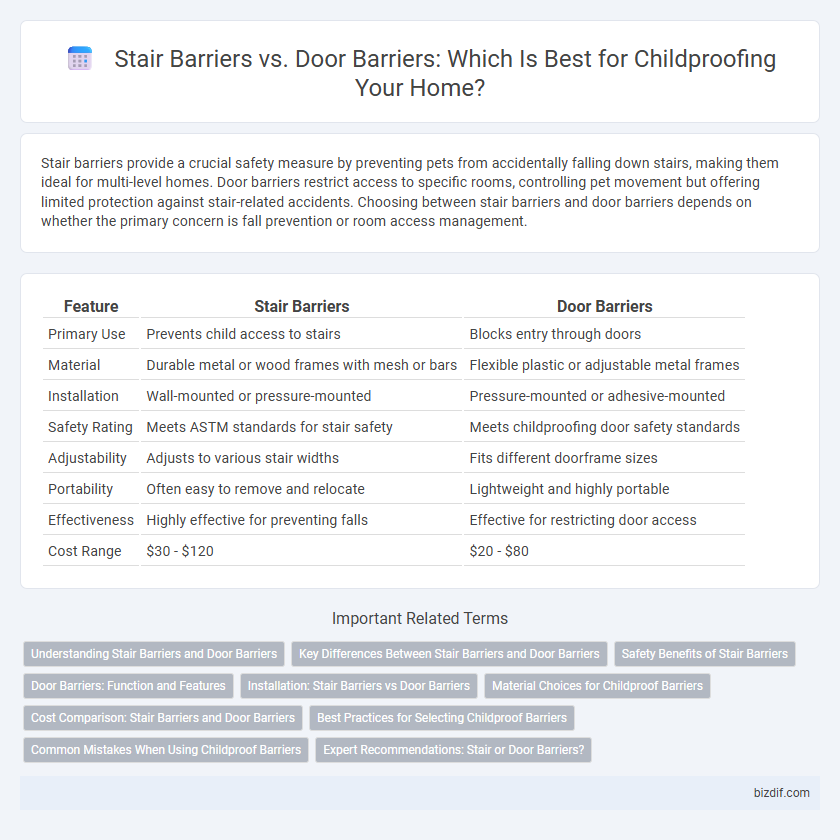Stair barriers provide a crucial safety measure by preventing pets from accidentally falling down stairs, making them ideal for multi-level homes. Door barriers restrict access to specific rooms, controlling pet movement but offering limited protection against stair-related accidents. Choosing between stair barriers and door barriers depends on whether the primary concern is fall prevention or room access management.
Table of Comparison
| Feature | Stair Barriers | Door Barriers |
|---|---|---|
| Primary Use | Prevents child access to stairs | Blocks entry through doors |
| Material | Durable metal or wood frames with mesh or bars | Flexible plastic or adjustable metal frames |
| Installation | Wall-mounted or pressure-mounted | Pressure-mounted or adhesive-mounted |
| Safety Rating | Meets ASTM standards for stair safety | Meets childproofing door safety standards |
| Adjustability | Adjusts to various stair widths | Fits different doorframe sizes |
| Portability | Often easy to remove and relocate | Lightweight and highly portable |
| Effectiveness | Highly effective for preventing falls | Effective for restricting door access |
| Cost Range | $30 - $120 | $20 - $80 |
Understanding Stair Barriers and Door Barriers
Stair barriers are specifically designed to prevent children from accessing staircases, reducing the risk of falls by securely fitting at the top or bottom of stairs with pressure-mounted or hardware-mounted options. Door barriers, on the other hand, restrict access to rooms or spaces entirely by blocking doorways, ensuring children cannot enter potentially hazardous areas like kitchens or basements. Both types of barriers use durable materials and childproof locking systems to enhance safety in homes.
Key Differences Between Stair Barriers and Door Barriers
Stair barriers are specifically designed to prevent children from accessing staircases, typically featuring tall, sturdy construction and pressure-mounted or hardware-mounted options for secure installation. Door barriers are intended to block entry through doorways, often lighter and more flexible, allowing adults to pass through easily while keeping children out. The key differences lie in their design purpose, installation method, and strength requirements, with stair barriers prioritizing maximum safety against falls and door barriers emphasizing accessibility control.
Safety Benefits of Stair Barriers
Stair barriers provide essential safety benefits by preventing children from accessing potentially dangerous staircases, significantly reducing the risk of falls and injuries. Unlike door barriers, stair barriers are specifically designed to be securely mounted on uneven surfaces and can withstand the pressure of a child leaning or pushing against them. Installing stair barriers ensures a safer home environment by creating a reliable physical boundary, especially in multi-level households.
Door Barriers: Function and Features
Door barriers provide effective childproofing by restricting access to hazardous areas such as kitchens, bathrooms, or stairwells. These barriers often feature pressure-mounted designs for easy installation without damaging walls, adjustable widths to fit various doorway sizes, and durable materials like metal or high-quality plastic for long-lasting safety. Equipped with secure locking mechanisms, door barriers ensure toddlers cannot open them while allowing adults to pass through conveniently.
Installation: Stair Barriers vs Door Barriers
Stair barriers are typically installed with pressure-mounted or hardware-mounted methods to ensure secure attachment to banisters or walls, providing reliable protection against falls. Door barriers usually use tension rods or adhesive mounts for quick installation that maintains doorframe integrity without permanent modifications. Proper installation of each barrier type is crucial for maximizing child safety and preventing accidents in high-risk areas like staircases and doorways.
Material Choices for Childproof Barriers
Stair barriers commonly feature durable materials such as solid wood or metal, ensuring sturdy support and long-term safety. Door barriers often utilize flexible mesh or plastic components, allowing easy installation and adaptability for various door widths. Selecting materials with non-toxic finishes and smooth surfaces is essential to prevent injury and guarantee child-friendly protection.
Cost Comparison: Stair Barriers and Door Barriers
Stair barriers typically cost between $30 and $100 depending on materials and installation complexity, while door barriers range from $25 to $80, offering a more budget-friendly option for restricting access. Professional installation for stair barriers can add $50 to $150, reflecting the higher safety standards required. Door barriers usually require less intensive installation, reducing overall expenses and making them a cost-effective choice for childproofing entryways.
Best Practices for Selecting Childproof Barriers
When selecting childproof barriers, stair barriers provide essential safety by preventing falls on staircases, while door barriers restrict access to hazardous areas such as kitchens or basements. Opt for pressure-mounted stair barriers for easy installation without drilling, ensuring they fit securely between banisters or walls. For door barriers, choose models with quick-release mechanisms to allow adults easy passage while maintaining childproof security.
Common Mistakes When Using Childproof Barriers
Common mistakes when using childproof barriers include incorrectly measuring staircases or doorways, leading to improper fits that compromise safety. Stair barriers often require secure mounting hardware and precise placement to prevent gaps that children can squeeze through, while door barriers may fail if hinges or locks are weak or improperly installed. Selecting the right type and ensuring robust installation are crucial to effectively prevent accidents and protect children from hazardous areas.
Expert Recommendations: Stair or Door Barriers?
Experts recommend stair barriers over door barriers for childproofing due to the higher risk of falls on stairs, which can cause serious injuries. Stair barriers, typically pressure-mounted or hardware-mounted gates, provide a secure physical barrier at the top and bottom of staircases, effectively preventing access to hazardous areas. Door barriers, while useful for restricting entry to specific rooms, do not address the critical safety concern of stairways and should be used as a supplementary measure.
Stair barriers vs Door barriers Infographic

 bizdif.com
bizdif.com